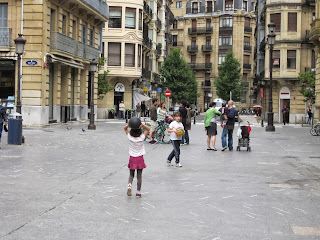 |
| Comal Springs and River, New Braunfels |
As promised, here is a list of our family's favorite natural swimming holes in the Austin area ("area" is defined pretty loosely here--we are willing to drive a good hour or more for a beautiful swimming hole). I have focused only on swimming holes that are accessible to the public, and I have also included a few of our favorite public pools. We are grateful that there are so many beautiful swimming spots in the area. I swam in several of these places as a child and love them just as much now as I did back then. As you can see from the pictures below, Central Texas definitely has some of the most beautiful rivers and creeks in the country.
 |
| Jacob's Well, Wimberly |
1.
Jacob's Well, Wimberly. An enchanting artesian spring that flows out of one of Texas's deepest underwater caves and supplies water for Cypress Creek. The water is very cold, and the biggest entertainment is jumping off the rocks into the water. Need to get there before the spring runs dry from new real estate developments in the area. Best to arrive in the morning.
2.
Comal Springs and River, New Braunfels. This is my hometown swimming hole. We like the headwaters in Landa Park for seeing the springs, although the water is not deep enough for big kids to swim here. For that, there's the spring-fed swimming pool in the park and tubing down the river. The springs are the largest in the American southwest.
3.
Perdenales Falls State Park. The Perdenales River is absolutely stunning here--and just a 45-minute drive from Austin.
4.
Blue Hole, Wimberly, Texas. Rope swings galore, spring-fed water, newly remodeled facilities, and beautiful grounds for picnicking along Cypress Creek. We went here last summer for the first time in years and will be back soon (as long as the creek does not run dry; see above).
5.
Deep Eddy Pool, Austin. The oldest swimming pool in Texas with wonderful spring-fed water. After swimming, we like to grab Jim-Jims water ices, or head over to the pizza restaurant next door.
6.
Barton Springs Pool, Austin. The crown jewel of Austin. Unfortunately, it took my kids 9 years before they could withstand the cold water here.
7. West Enfield Pool, Austin. It's hardly ever open (only 2 months in the summer), but has great shade and is a good spot to go if your kids cannot stand the cold water at Deep Eddy and Barton Springs.
8. Barton Creek Greenbelt, Austin. The Greenbelt often does not have water, but when it does, this is a delightful place to visit. We like the Gus Fruh pool, accessed from the Barton Hills neighborhood at the Gus Fruh entrance. Mornings are best to avoid the crowds and un-family friendly activities.
 |
| Perdenales Falls State Park |
9.
McKinney Falls State Park. The swimming hole can be a bit murky, depending on the prior weather, but we discovered this past May that the creek above the falls is wonderful to splash around in, and the kids did not mind the murk.
10. The Llano Slabs, Kingsland. Shallow rapids section of the Llano River with small pools of water to sit in and small river shoots that kids can ride down in tubes or on their bottoms if they are brave. We usually stop by here when we are visiting Lake LBJ and then head up to Cooper's barbecue in Llano. Hard to find: Take Ranch Road 3404 from Kingsland.
Two favorites that don't fall within my definition of "Austin area," but are worth driving to, especially if you can stay the night, are Mo Ranch and Colorado Bend State Park. We discovered Colorado Bend last fall and will be back this November--it's very remote with gorgeous river-front campsites. Mo Ranch is on a dammed section of the Guadalupe River and has a crazy, scream-producing wooden sled that shoots you out into the river, rope swings, and beautiful rapids to explore. Most visitors are staying the night at Mo Ranch, but you can also purchase a day pass.
 |
| McKinney Falls State Park |
 |
| Colorado Bend State Park |
 |
| Mo Ranch -- The Crazy River Sled |
 |
| Guadalupe River near Mo Ranch |









































